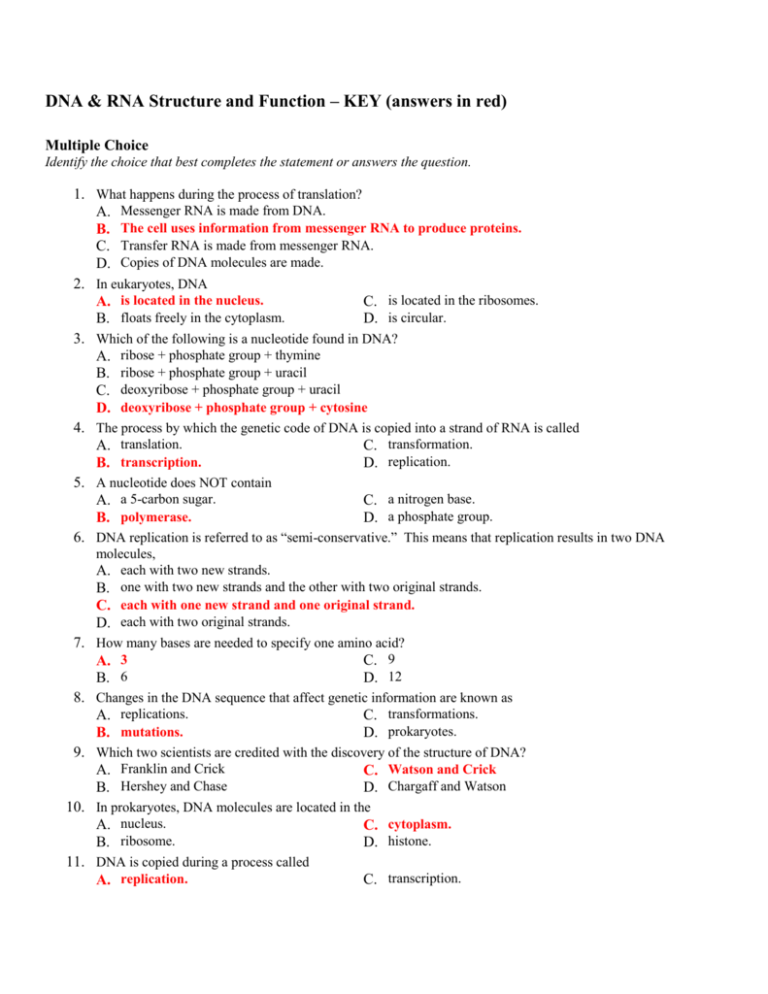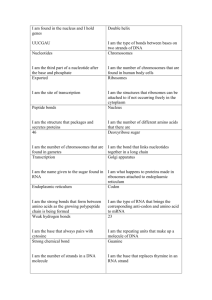DNA & RNA Structure and Function
advertisement

DNA & RNA Structure and Function – KEY (answers in red) Multiple Choice Identify the choice that best completes the statement or answers the question. 1. What happens during the process of translation? A. Messenger RNA is made from DNA. B. The cell uses information from messenger RNA to produce proteins. C. Transfer RNA is made from messenger RNA. D. Copies of DNA molecules are made. 2. In eukaryotes, DNA C. is located in the ribosomes. A. is located in the nucleus. B. floats freely in the cytoplasm. D. is circular. 3. Which of the following is a nucleotide found in DNA? A. ribose + phosphate group + thymine B. ribose + phosphate group + uracil C. deoxyribose + phosphate group + uracil D. deoxyribose + phosphate group + cytosine 4. The process by which the genetic code of DNA is copied into a strand of RNA is called A. translation. C. transformation. D. replication. B. transcription. 5. A nucleotide does NOT contain A. a 5-carbon sugar. C. a nitrogen base. polymerase. D. a phosphate group. B. 6. DNA replication is referred to as “semi-conservative.” This means that replication results in two DNA molecules, A. each with two new strands. B. one with two new strands and the other with two original strands. C. each with one new strand and one original strand. D. each with two original strands. 7. How many bases are needed to specify one amino acid? C. 9 A. 3 6 B. D. 12 8. Changes in the DNA sequence that affect genetic information are known as A. replications. C. transformations. D. prokaryotes. B. mutations. 9. Which two scientists are credited with the discovery of the structure of DNA? A. Franklin and Crick C. Watson and Crick B. Hershey and Chase D. Chargaff and Watson 10. In prokaryotes, DNA molecules are located in the A. nucleus. C. cytoplasm. B. ribosome. D. histone. 11. DNA is copied during a process called C. transcription. A. replication. B. translation. D. transformation. 12. A mutation that involves one or a few nucleotides is called a(an) A. chromosomal mutation. C. point mutation. B. inversion. D. translocation. 13. RNA contains the sugar C. glucose. A. ribose. B. deoxyribose. D. lactose. 14. During DNA replication, a DNA strand that has the bases CTAGGT produces a strand with the bases A. TCGAAC. C. AGCTTG. D. GAUCCA. B. GATCCA. 15. Why is it possible for an amino acid to be specified by more than one kind of codon? A. Some codons have the same sequence of nucleotides. B. There are 64 different kinds of codons but only 20 amino acids. C. Some codons do not specify an amino acid. D. The codon AUG codes for the amino acid methionine and serves as the “start” codon for protein synthesis. 16. Which RNA molecule carries amino acids? A. messenger RNA B. transfer RNA C. ribosomal RNA D. RNA polymerase 17. What is produced during transcription? C. RNA polymerase A. RNA molecules DNA molecules B. D. proteins 18. In messenger RNA, each codon specifies a particular A. nucleotide. C. amino acid. B. purine. D. pyrimidine. Completion Complete each statement. Figure 12–1 19. The dotted lines in Figure 12-1 represent __hydrogen bonds__________ which hold the two strands of DNA together. 20. The structure labeled X in Figure 12–1 is a(an) __nucleotide________. 21. Adenine and guanine represent a type of double-ring compounds called ___purines________. 22. Cytosine and thymine represent a type of single-ring compounds called __pyrimidines_____. 23. The “backbone” of a DNA molecule is made of __sugar______ and __phosphate_______ molecules. Figure 12–3 24. In Figure 12–3, A, B, and C are three types of __RNA_______________. 25. The order of nitrogenous bases in DNA determines the order of ___amino acids______ in proteins. 26. According to the principle of __base pairing______, hydrogen bonds can form only between adenine and thymine, and between guanine and cytosine. 27. The codon that signals the end of a growing polypeptide is called a (an) __stop codon__. 28. A set of three tRNA bases called a(n) __anticodon_________ is complementary to three consecutive nucleotides on an mRNA molecule. Short Answer Figure 12–2 29. According to Figure 12–2, what amino acids are indicated by the following codons? a. CAC - histidine b. UUA - leucine c. GCU - alanine d. AAA - lysine 30. What process is indicated by the X above? Where in the cell does it occur? transcription; nucleus 31. What process is indicated by the Y above? Where in the cell does it occur? translation; cytoplasm Matching Match each label to the appropriate description. A. A B. B C. C 32. Nucleus A D. D E. E F. F 33. 34. 35. 36. 37. Ribosome C tRNA D Anticodon E Codon F mRNA B Indicate if each of the following is a characteristic of DNA or RNA. A. DNA 38. 39. 40. 41. 42. 43. B. RNA Single-stranded B Shape is a double-stranded helix A Found only in the nucleus of a cell A Contains the nitrogen base Uracil B Contains the sugar deoxyribose A Three different types B Essay 44. Name and give the function of the each type of RNA molecule. mRNA – carries the genetic code from DNA to the ribosomes rRNA – with proteins, makes up the ribosomes tRNA – reads the message of mRNA and brings the Amino Acids to link together 45. BONUS: List and explain/illustrate two different types of mutations that may occur in DNA







